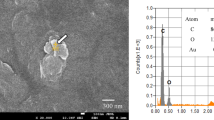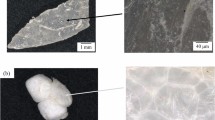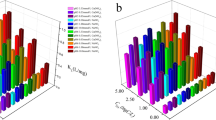Abstract
Marine ecosystem degradation due to microplastic pollution is a significant environmental problem, as acknowledged by Sustainable Development Goal 14. Decomposition of plastics using near critical or supercritical water is a promising method to remove microplastics. To optimize this method for realizing environmental benefits, it is necessary to clarify the structural change of materials during the process. Thus, we investigated the decomposition processes of polystyrene particles dispersed in deuterated water (D2O) during heating under near critical or supercritical conditions by using in situ small-angle neutron scattering. Under subcritical conditions, the PS particles were swollen by D2O due to increased compatibility with temperature. In subcritical conditions near the critical point, cleavage of PS chains in the particles occurred, so that the swollen ratio was enhanced despite the PS particles keeping their shapes. Under supercritical conditions, the PS particles were degraded into oil, including oligomers or monomers and phase-separated structures with styrene-rich and D2O-rich regions.
This is a preview of subscription content, access via your institution
Access options
Subscribe to this journal
Receive 12 print issues and online access
$259.00 per year
only $21.58 per issue
Buy this article
- Purchase on Springer Link
- Instant access to full article PDF
Prices may be subject to local taxes which are calculated during checkout



Similar content being viewed by others
References
Hungenberg K-D, Jahns E. Trends in emulsion polymerization processes from an industrial perspective. In: Pauer W, editor. Polymer reaction engineering of dispersed systems, Volume I. Cham: Springer International Publishing; 2018. p. 195–214.
McDonald CJ, Devon MJ. Hollow latex particles: synthesis and applications. Adv Colloid Interface Sci. 2002;99:181–213. https://doi.org/10.1016/S0001-8686(02)00034-9
Gopinath PM, Parvathi VD, Yoghalakshmi N, Kumar SM, Athulya PA, Mukherjee A. et al. Plastic particles in medicine:a systematic review of exposure and effects to human health. Chemosphere. 2022;303:135227 https://doi.org/10.1016/j.chemosphere.2022.135227.
Kausar A. A review of high performance polymer nanocomposites for packaging applications in electronics and food industries. J Plast Film Sheeting. 2020;36:94–112. https://doi.org/10.1177/8756087919849459
Law KL, Thompson RC. Microplastics in the seas. Science. 2014;345:144–5. https://doi.org/10.1126/science.1254065
Walker TR.Microplastics and the UN sustainable development goals.Curr Opin Green Sustain Chem. 2021;30:100497 https://doi.org/10.1016/j.cogsc.2021.100497.
Laredo GC, Reza J, Meneses Ruiz E. Hydrothermal liquefaction processes for plastics recycling: a review. Clean Chem Eng. 2023;5:100094 https://doi.org/10.1016/j.clce.2023.100094.
Lilac WD, Lee S. Kinetics and mechanisms of styrene monomer recovery from waste polystyrene by supercritical water partial oxidation. Adv Environ Res. 2001;6:9–16. https://doi.org/10.1016/S1093-0191(00)00066-6
Kwak H, Shin HY, Bae SY, Kumazawa H. Characteristics and kinetics of degradation of polystyrene in supercritical water. J Appl Polym Sci. 2006;101:695–700. https://doi.org/10.1002/app.23896
Bai B, Jin H, Fan C, Cao C, Wei W, Cao W. Experimental investigation on liquefaction of plastic waste to oil in supercritical water. Waste Manag. 2019;89:247–53. https://doi.org/10.1016/j.wasman.2019.04.017
Polysciences Inc. Polybead® Polystyrene Microspheres: Frequently Asked Questions. https://www.polysciences.com/media/pdf/technical-data-sheets/238-Polystyrene-FAQ.pdf (2009)
Alargova RG, Deguchi S, Tsujii K. Dynamic light scattering study of polystyrene latex suspended in water at high temperatures and high pressures. Colloids Surf A Physicochem Eng Asp. 2001;183–185:303–12. https://doi.org/10.1016/S0927-7757(01)00544-1
Porod G. Die Röntgenkleinwinkelstreuung von dichtgepackten kolloiden Systemen. Kolloid-Zeitschrift. 1951;124:83–114. https://doi.org/10.1007/BF01512792
Guinier A, Fournet G. Small-angle scattering of X-rays. New York: Wiley; 1955.
NIST Center for Neutron Research. Neutron Activation and Scattering Calculator. https://www.ncnr.nist.gov/resources/activation/ (2022)
Bell IH, Wronski J, Quoilin S, Lemort V. Pure and pseudo-pure fluid thermophysical property evaluation and the open-source thermophysical property library coolprop. Ind Eng Chem Res. 2014;53:2498–508. https://doi.org/10.1021/ie4033999
Quach A, Simha R. Pressure‐volume‐temperature properties and transitions of amorphous polymers; polystyrene and poly (orthomethylstyrene). J Appl Phys. 1971;42:4592–606. https://doi.org/10.1063/1.1659828
Stanley HE. Introduction to phase transitions and critical phenomena. New York: Oxford University Press; 1971
Yabalak E, Akay S, Kayan B, Gizir AM, Yang Y. SolubIlity and decomposition of organic compounds in subcritical water. Molecules. 2023; 28 https://doi.org/10.3390/molecules28031000
Bellissent-Funel M-C, Tassaing T, Zhao H, Beysens D, Guillot B, Guissani Y. The structure of supercritical heavy water as studied by neutron diffraction. J Chem Phys. 1997;107:2942–9. https://doi.org/10.1063/1.475155
Acknowledgements
This work was partly supported by the JSPS KAKENHI Grant-in-Aid for Science Research (B) (grant No. JP23H01698) and Grant-in-Aid for Science Research (S) (grant No. JP 21H05027). The SANS experiments were performed using SANS-J at JRR-3 under the user program (proposal No. 2022A-A23). We thank Prof. Yoshinobu Tsujii and Prof. Yuji Kinose for the SEC measurement (Kyoto University). The authors acknowledge the support of the Quantum Beam Analyses Alliance (QBAA).
Author information
Authors and Affiliations
Corresponding authors
Ethics declarations
Conflict of interest
The authors declare no competing interests.
Additional information
Publisher’s note Springer Nature remains neutral with regard to jurisdictional claims in published maps and institutional affiliations.
Supplementary information
Rights and permissions
Springer Nature or its licensor (e.g. a society or other partner) holds exclusive rights to this article under a publishing agreement with the author(s) or other rightsholder(s); author self-archiving of the accepted manuscript version of this article is solely governed by the terms of such publishing agreement and applicable law.
About this article
Cite this article
Shibata, M., Nakanishi, Y., Abe, J. et al. Structural changes of polystyrene particles in subcritical and supercritical water revealed by in situ small-angle neutron scattering. Polym J 55, 1165–1170 (2023). https://doi.org/10.1038/s41428-023-00817-1
Received:
Revised:
Accepted:
Published:
Issue Date:
DOI: https://doi.org/10.1038/s41428-023-00817-1



